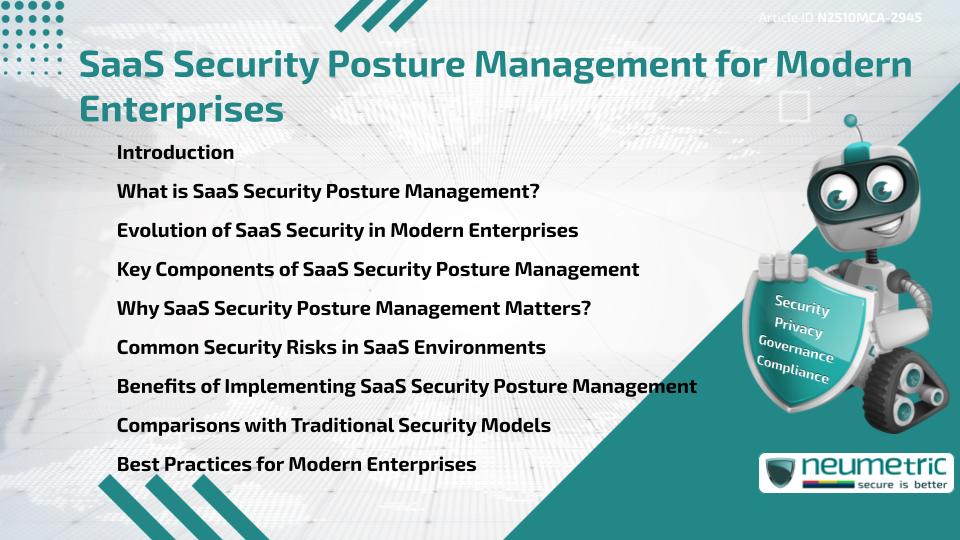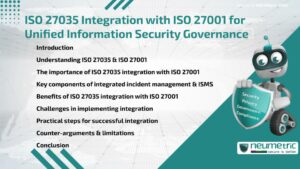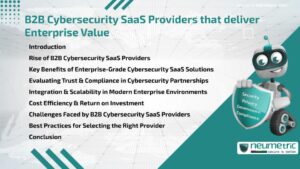Table of Contents
ToggleIntroduction
SaaS security posture management is becoming essential as modern enterprises increasingly rely on cloud-based applications. With the rise of remote work & decentralized IT ecosystems, security teams face new challenges in managing Risk across multiple Software-as-a-Service [SaaS] platforms. SaaS security posture management offers continuous visibility, compliance monitoring & configuration oversight. This article explores its definition, evolution, benefits & Best Practices for enterprises striving for robust security in a SaaS-first world.
What is SaaS Security Posture Management?
SaaS security posture management [SSPM] refers to the process & tools that continuously assess & manage the security configurations of SaaS applications. It ensures that User access, data sharing & configuration settings comply with organisational & regulatory Policies. SSPM operates much like a Security Control center, offering visibility into how applications are secured & identifying misconfigurations that could lead to breaches.
Evolution of SaaS Security in Modern Enterprises
The adoption of SaaS began in the early 2000s with productivity & collaboration tools like Salesforce & Google Workspace. Over time, enterprises shifted most business functions to SaaS solutions for scalability & flexibility. However, this transformation brought challenges: inconsistent configurations, shadow IT & lack of centralized visibility. To address these issues, SaaS security posture management emerged as a proactive approach, combining automation with policy-driven Governance.
Key Components of SaaS Security Posture Management
An effective SaaS security posture management Framework typically includes:
- Configuration Monitoring: Continuous evaluation of security settings across SaaS applications.
- Identity & Access Management: Ensuring appropriate User permissions & minimizing privilege creep.
- Data Loss Prevention: Identifying risky data-sharing practices.
- Threat Detection: Monitoring unusual activities within connected apps.
- Compliance Management: Mapping configurations to Standards such as ISO 27001, SOC 2 & GDPR.
These components collectively maintain a strong, compliant & resilient SaaS environment.
Why SaaS Security Posture Management Matters?
SaaS ecosystems are complex & dynamic. Misconfigurations in applications such as Microsoft 365, Slack or Salesforce can expose Sensitive Data. SSPM helps mitigate these Risks by providing automated alerts, configuration baselines & corrective recommendations. For compliance-heavy industries like Finance or Healthcare, SaaS security posture management ensures continuous adherence to regulatory mandates.
Common Security Risks in SaaS Environments
Some of the most prevalent SaaS security Risks include:
- Excessive User permissions & poor Access Control
- Unsecured integrations with Third Party apps
- Misconfigured data-sharing settings
- Lack of visibility into User activity
- Unencrypted data transfers
Without proper SSPM tools, these Vulnerabilities can lead to data breaches, compliance violations & reputational damage.
Benefits of Implementing SaaS Security Posture Management
Adopting SaaS security posture management delivers several key advantages:
- Real-time visibility across all SaaS applications
- Automated detection & correction of misconfigurations
- Reduced Likelihood of insider Threats & data exposure
- Improved Audit readiness & compliance alignment
- Streamlined Incident Response through centralized monitoring
Ultimately, SSPM helps enterprises move from reactive to proactive security management.
Comparisons with Traditional Security Models
Traditional security models focus on network perimeters & on-premises infrastructure. In contrast, SaaS security posture management extends protection beyond traditional boundaries. While firewalls & endpoint tools secure internal systems, SSPM secures the SaaS layer — where business data now resides. It complements cloud access security brokers [CASB] and identity management systems by providing deeper visibility into application configurations.
Best Practices for Modern Enterprises
To effectively implement SaaS security posture management, enterprises should:
- Inventory all SaaS applications in use
- Define configuration baselines aligned with security Standards
- Automate Continuous Monitoring & alerts
- Regularly review access privileges
- Train Employees on secure SaaS usage
- Integrate SSPM tools with existing security platforms
Conclusion
SaaS security posture management empowers modern enterprises to maintain control over increasingly complex cloud ecosystems. By automating monitoring, enforcing Best Practices & ensuring compliance, SSPM enhances resilience against evolving Threats. As Organisations continue their digital transformation, adopting SSPM is no longer optional — it’s essential.
Takeaways
- SaaS security posture management ensures continuous visibility & compliance.
- SSPM automates detection & remediation of SaaS misconfigurations.
- It reduces Risks associated with User access & data sharing.
- Unlike traditional security, SSPM focuses on the SaaS application layer.
- Best Practices include automation, access reviews & integration with existing tools.
FAQ
What is SaaS security posture management?
It is the process of continuously monitoring & managing SaaS application configurations to ensure security & compliance.
Why is SaaS security posture management important?
It protects Sensitive Data, prevents misconfigurations & ensures compliance across multiple SaaS platforms.
How does SaaS security posture management differ from CASB?
While CASB focuses on Access Control, SSPM provides Continuous Monitoring of configurations & compliance.
Which industries benefit most from SaaS security posture management?
Industries such as Finance, Healthcare & technology that handle Sensitive Data gain the most from SSPM.
Can SaaS security posture management prevent data breaches?
It helps prevent breaches by identifying & correcting risky configurations before attackers exploit them.
What tools are used for SaaS security posture management?
Popular SSPM tools include Adaptive Shield, Obsidian Security, AppOmni & SSPM modules in broader platforms.
How can enterprises start implementing SaaS security posture management?
They should assess their current SaaS usage, deploy an SSPM solution & integrate it with their existing security ecosystem.
Need help for Security, Privacy, Governance & VAPT?
Neumetric provides organisations the necessary help to achieve their Cybersecurity, Compliance, Governance, Privacy, Certifications & Pentesting needs.
Organisations & Businesses, specifically those which provide SaaS & AI Solutions in the Fintech, BFSI & other regulated sectors, usually need a Cybersecurity Partner for meeting & maintaining the ongoing Security & Privacy needs & requirements of their Enterprise Clients & Privacy conscious Customers.
SOC 2, ISO 27001, ISO 42001, NIST, HIPAA, HECVAT, EU GDPR are some of the Frameworks that are served by Fusion – a SaaS, multimodular, multitenant, centralised, automated, Cybersecurity & Compliance Management system.
Neumetric also provides Expert Services for technical security which covers VAPT for Web Applications, APIs, iOS & Android Mobile Apps, Security Testing for AWS & other Cloud Environments & Cloud Infrastructure & other similar scopes.
Reach out to us by Email or filling out the Contact Form…





